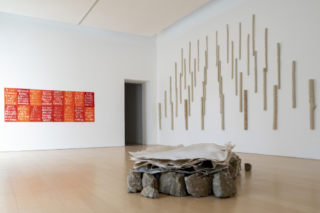
Cova 2021
handmade paper, stones, hydrocarbons
Commissioned for Rethinking Nature
Courtesy of the artist and Nicola Pedana Arte Contemporanea
Ivano Troisi’s practice analyses ecological phenomena and the transformations brought to landscapes by human intervention. In his practice, particular attention is given to his native region of Campania and the South of Italy, which are regarded as research sites for the development of new ethical relations with nature. Troisi articulates through a variety of artistic mediums processes through which to reimagine such relations. Cova is part of an ongoing research initiated by the artist in 2014 in Val d’Agri, a region of Basilicata in which the Italian multinational oil and gas company ENI operates an extraction site. Petrol was discovered in this area in 1991. The region was then turned by ENI into Italy’s largest oil development, with over 75,000 barrels extracted daily. The material is subsequently sent through an oil pipeline to a refinery in Taranto, in the neighboring region of Puglia. During the site visits conducted over the years, the artist has observed the increasing ecological repercussions of these extractive processes, which have raised growing concern among environmental organizations. The resulting sculpture features layers of hand-crafted paper, made by the artist at the extraction site as a way to crystallize the specificities of the place and installed on a bed of rocks also taken from the ENI oil site. By metaphorically reconstructing the landscape of Val d’Agri, the artist reverses the process of extraction by placing hydrocarbons sampled from the site at the top of this symbolical geological stratification, allowing oil to penetrate the layers of paper. Throughout the duration of the exhibition, the work continues to mutate as the petrol components reach new layers, echoing the forced piercing of the land undertaken by oil drills in Basilicata.
Artist statement
I begin from the observation of nature to implement an analysis of the processes that characterise its transformations and mutations. Nature is the object of a process of contemplation, which then becomes one of documentation, to resolve itself into a cognitive and scientific mechanism. This approach is not limited to the theoretical sphere, but spills over into a technical aspect: I make the papers that are the basis of my work, documenting the different types and traditions of making them. Sculptural craftsmanship is important to me; it takes shape through woodcuts, stamps, watermarks, drawings, in which light and delicate signs sometimes emphasise an organic aspect, others transmute into abstract elements, in an apparent game that at the same time reveals and conceals the essence of nature.